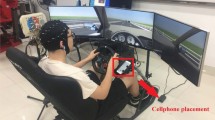Abstract
A novel detective model for driver distraction was proposed in this study. Driver distraction is a significant cause of traffic accidents during these years. To study human cognition under a specific driving task, one virtual reality (VR)-based simulation was built. Unexpected car deviations and mathematics questions with stimulus onset asynchrony (SOA) were designed. Electroencephalography (EEG) is a good index for the distraction level to monitor the effects of the dual tasks. Power changing in Frontal and Motor cortex were extracted for the detective model by independent component analysis (ICA). All distracting and non-distracting EEG epochs could be revealed the existence by self-organizing map (SOM). The results presented that this system approached about 90% accuracy to recognize the EEG epochs of non-distracting driving, and might be practicable for daily life.
Access this chapter
Tax calculation will be finalised at checkout
Purchases are for personal use only
Preview
Unable to display preview. Download preview PDF.
Similar content being viewed by others
References
Dukic, T.H., Hanson, L., Falkmer, T.: Effect of drivers’ age and push button locations on visual time off road, steering wheel deviation and safety perception. Ergonomics 49, 78–92 (2006)
Cross, G.W.: Distracted Driving in Mississippi: A Statewide Survey and Summary of Related Research and Policies. Mississippi (2010)
Young, K., Regan, M., Faulks, I.J., Stevenson, M., Brown, J., Irwin, J.D.: Driver distraction: A review of the literature. NSW: Australian College of Road Safety, 379–405 (2007)
Lin, C.T., Liao, L.D., Liu, Y.H., Wang, I.J., Lin, B.S., Chang, J.Y.: Novel Dry Polymer Foam Electrodes for Long-Term EEG Measurement. IEEE Transactions on Biomedical Engineering 58(5), 1200–1207 (2011)
McFarland, D.J., Anderson, C.W., Muller, K.R., Schlogl, A., Krusienski, D.J.: Bci meeting 2005-workshop on bci signal processing: feature extraction and translation. IEEE Transactions on Neural Systems and Rehabilitation Engineering 14(2), 135–138 (2006)
Makeig, S., Bell, A.J., Jung, T.P., Sejnowski, T.J.: Independent component analysis of electroencephalographic data. In: Advances in Neural Information Processing Systems, pp. 145–151 (1996)
Kohonen, T.: The self-organizing map. Proceedings of the IEEE 78(9), 1464–1480 (1990)
Comon, P.: Independent component analysis, A new concept? Signal Processing 36(3), 287–314 (1994)
Jung, T.P., Making, S., Humphries, C., Lee, T.W., Mckeown, M.J., Iragui, V., Sejnowski, T.J.: Removing electroencephalographic artifacts by blind source separation. Psychophysiology 37, 163–178 (2000)
Lin, C.T., Chen, S.A., Chiu, T.T., Lin, H.Z., Ko, L.W.: Spatial and temporal EEG dynamics of dual-task driving performance. Journal of NeuroEngineering and Rehabilitation 8(1), 11–23 (2011)
Wang, Y.K., Pal, N.R., Lin, C.T., Chen, S.A.: Analyzing effect of distraction caused by dual-tasks on sharing of brain resources using SOM. In: The International Joint Conference on Neural Networks, Barcelona (2010)
Joutsiniemi, S.L., Kaski, S., Larsen, T.A.: Self-organizing map in recognition of topographic patterns of EEG spectra. IEEE Transactions on Biomedical Engineering 42(11), 1062–1068 (1995)
Laboratory of Computer and Infromation Science, http://www.cis.hut.fi
Lv, J.C., Tan, K.K., Yi, Z., Huang, S.: A Family of Fuzzy Learning Algorithms for Robust Principal Component Analysis Neural Networks. IEEE Transations on Fuzzy Systems, 217–226 (2010)
Song, H., Miao, C., Roel, W., Shen, Z., Catthoor, F.: Implementation of Fuzzy Cognitive Maps Based on Fuzzy Neural Network and Application in Prediction of Time Series. IEEE Transations on Fuzzy Systems, 233–250 (2010)
Juang, C.F., Hsieh, C.D.: A Locally Recurrent Fuzzy Neural Network With Support Vector Regression for Dynamic-System Modeling. IEEE Transations on Fuzzy Systems, 261–273 (2010)
Juang, C.F., Huang, R.B., Cheng, W.Y.: An Interval Type-2 Fuzzy-Neural Network With Support-Vector Regression for Noisy Regression Problems. IEEE Transations on Fuzzy Systems, 686–699 (2010)
Han, H., Qiao, J.: A Self-Organizing Fuzzy Neural Network Based on a Growing-and-Pruning Algorithm. IEEE Transations on Fuzzy Systems, 1129–1143 (2010)
Author information
Authors and Affiliations
Editor information
Editors and Affiliations
Rights and permissions
Copyright information
© 2011 Springer-Verlag Berlin Heidelberg
About this paper
Cite this paper
Lin, CT., Wang, YK., Chen, SA. (2011). An EEG-Based Brain-Computer Interface for Dual Task Driving Detection. In: Lu, BL., Zhang, L., Kwok, J. (eds) Neural Information Processing. ICONIP 2011. Lecture Notes in Computer Science, vol 7062. Springer, Berlin, Heidelberg. https://doi.org/10.1007/978-3-642-24955-6_83
Download citation
DOI: https://doi.org/10.1007/978-3-642-24955-6_83
Publisher Name: Springer, Berlin, Heidelberg
Print ISBN: 978-3-642-24954-9
Online ISBN: 978-3-642-24955-6
eBook Packages: Computer ScienceComputer Science (R0)




